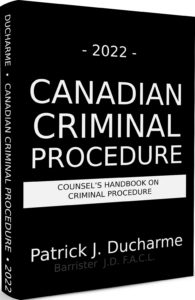 |
| Patrick J Ducharme |
Section 34 of the Criminal Code codifies the defence of self defence or the defence of another person. Under this section the accused is justified in acting in defence of himself, or, another person, if three conditions are presented in evidence. They are:
1. The accused must reasonably believe that a force is being used against him or another person or the threat of force is being used against him or another person;
2. The accused’s actions are committed for the purpose of defending or protecting himself or the other person from that use or threat of force; and,
3. The accused’s actions in response were reasonable in the circumstances.
In determining whether the act committed by the accused is reasonable in the circumstances, the court is required to consider the relevant circumstances of the person, the other parties, and the act, including but not limited to the following factors:
a. the nature of the force or threat.
b. the extent to which the use of force was imminent and whether there were other means available to respond to the potential use of force.
c. the person’s role in the incident.
d. whether any party to the incident used or threatened to use a weapon.
e. the size, age, gender and physical capabilities of the parties to the incident.
f. the nature, duration and history of any relationship between the parties to the incident, including any prior use or threat of force, and the nature of that force or threat.
g. any history of interaction or communication between the parties to the incident.
h. the nature and proportionality of the person’s response to the use or threat of force; and,
i. whether the act committed was in response to a use or threat of force that the person knew was lawful.
This revised section of the Code presents one caveat and that is, that the defence is not available if the force used or threatened by another person for the purpose of doing something that they are required or authorized by law to do in the administration or enforcement of the law, unless the person who commits the act that constitutes the offence believes on reasonable grounds that the other person is acting unlawfully.
The issue is not whether the accused was, in fact, unlawfully assaulted. The issue is whether the accused reasonably believed, in the circumstances, that he was being unlawfully assaulted. The imminence of apprehended danger is just one factor that a trier of fact must weigh in determining whether the accused had a reasonable apprehension of danger and a reasonable belief that he could not extricate himself otherwise than by the actions that he took.
Usually, the circumstances leading to a claim of self defence by the accused occur when the accused has performed acts that would otherwise be a crime, but claims he did so to defend himself, or to protect others, from the actual or threatened use of force against him or the other person. If his actions fall within section 34 of the Code, the court may find him to be acting lawfully and not guilty of the charge or charges against him.
Anyone who acts in self defence to protect himself, or another person, cannot be expected to know with precise measure how to respond, or what measure of force is needed for the protection. The actions of the accused will be measured against the likely actions of a reasonable person in the same circumstances. The law of self defence requires that the accused’s acts in self defence are the actions of a sane and sober person, not exceptionally excitable, or aggressive, or fearful.

The above is the an excerpt of Patrick J Ducharme's book, Canadian Criminal Procedure, available at Amazon or in bulk through MedicaLegal Publishing along with Criminal Trial Strategies.
Subscribe to Patrick Ducharme's Youtube Channel
